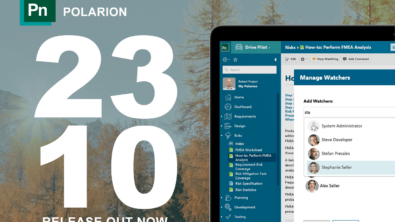Changing Lanes Quickly and Safely with Automotive ALM

 Polarion: Changing Lanes Quickly and Safely with Automotive ALM
Polarion: Changing Lanes Quickly and Safely with Automotive ALM
There are few things more ubiquitous today than your car, especially within the fast-paced confines of our commuter culture. Now, as of 2016, no living generation can claim the automobile as anything less than the quintessential means of transportation.
As such, consumers expect new vehicles to provide expedient travel from place to place, better fuel economy year-over-year, and an assurance that the roads are growing more secure with added safety features.
Manufacturers are perpetually striking a balance between providing cost-effective hardware improvements that will simultaneously satisfy the evolving requirements of style, safety, and compliance. That’s more or less been the auto industry goal for 30+ years.
Polarion ALM and the Helix VCS from Perforce are uniquely capable of carrying that torch further, producing a collaborative, Single Source of Truth for automotive DevOps workflows. In the face of an evolving industry where software and hardware integrate, where project source code must be traced and linked among autonomous teams in the enterprise, where industry regulations must be followed across distributed teams, the stakes have never been higher.
That’s because consumer demand is scaling rapidly, beyond mere OEM fabrication, as buyers look to pair their automobiles with the same feature-rich technologies they leverage off the road. Just as phones, watches, and televisions have become “smart”, so too must automobiles.
The number of networked cars (vehicles actively connected to the internet) will rise 30 percent a year for the next several years, with one in five cars connected by 2020, according to a study from the consultancy firm McKinsey & Company.
This new landscape that the modern automaker faces – a confluence of ALM-PLM integration and continuous delivery of auto derivatives – is made even more complex with increasingly robust compliance standards from environmental and safety regulators.
The auto industry has seen record highs in auto recalls, first in 2014 and again in 2015, with signs pointing to growing scrutiny from increasingly proactive automotive regulators, according to the Stout Risius Ross (SRR) Automotive Warranty and Recall Report.
Car manufacturers must innovate essentially the brains and the body of new vehicles at the same time – providing safer braking, steering, and suspension systems for vehicles while also integrating danger-warning applications, traffic information services, and infotainment software.
But this rising complexity for automakers is not reflected in the “sticker price” seen by consumers in most dealer showrooms. The automobile price-cost gap has narrowed steadily for 20 years, with an industry analysis showing flat inflation-adjusted prices for 76 vehicle models since 1998.
More features, added competition, and stricter regulation has created a net decline in profit per vehicle. But OEMs, and the industry at large have survived by increasing efficiencies and quality in their workflows.
Further, manufacturers can abate some of their price-cost woes by preventing recall loss from occurring in the first place. With exceptional source code clarity and traceability built-in to their ALM and VCS workflows, partners leveraging Polarion and Perforce together can avoid these real-world recalls:
• In 2015, 1.4 million Jeep Cherokee’s were recalled after the FCA determined the built-in entertainment system was vulnerable to hackers seeking system control remotely.
• Jaguar Land Rover recalled 65,000 SUVs when a glitch in the keyless entry software was discovered that caused some of the vehicles’ doors to swing open unexpectedly, creating hazardous operating conditions.
• General Motors recalled 30 million cars worldwide, starting in February 2014, after ignition switch failures caused the hazardous operation of myriad models, resulting in 124 deaths and $900 million in a federal prosecution agreement.
While it isn’t the norm, technology-related or systems-related recalls are not rare, with 900 separate recall actions in 2015 alone, according to the National Highway Traffic Safety Administration (NHTSA).
P4Polarion Connector users have an advantage when it comes to circumventing these development pratfalls. That’s because, with the Perforce versioning engine, you can trace development source code changes on all your Polarion Work Items, offering greater control throughout the development lifecycle and across federated projects.
When the unfortunate does happen, it is even easier to generate software defects that are linked to specific requirements and the associated code.
With better collaboration, access control, traceability, compliance, and scalability for distributed teams, Polarion users benefit from Perforce’s granular security, real-time collaboration, global workflows, and highly-automated QA and CD support. To learn more, please don’t hesitate to get in touch with us by clicking on this page.


